The Economic Contribution of Melbourne's Foodbowl: An In-depth Essay
VerifiedAdded on 2023/06/13
|5
|877
|83
Essay
AI Summary
This essay examines the economic contribution of Melbourne's foodbowl to the regional economy of Victoria, Australia, based on Deloitte's report. Melbourne's foodbowl, comprising over 1.7 million hectares, significantly contributes to the regional gross product, providing employment and agricultural produce. The analysis highlights the impact of urbanization on the foodbowl, leading to reduced agricultural land and increased food demand, potentially raising food prices. The essay recommends strategic land-use planning to balance urban development and food production, ensuring the foodbowl's sustainability. Desklib offers more resources for students studying economics and regional development.
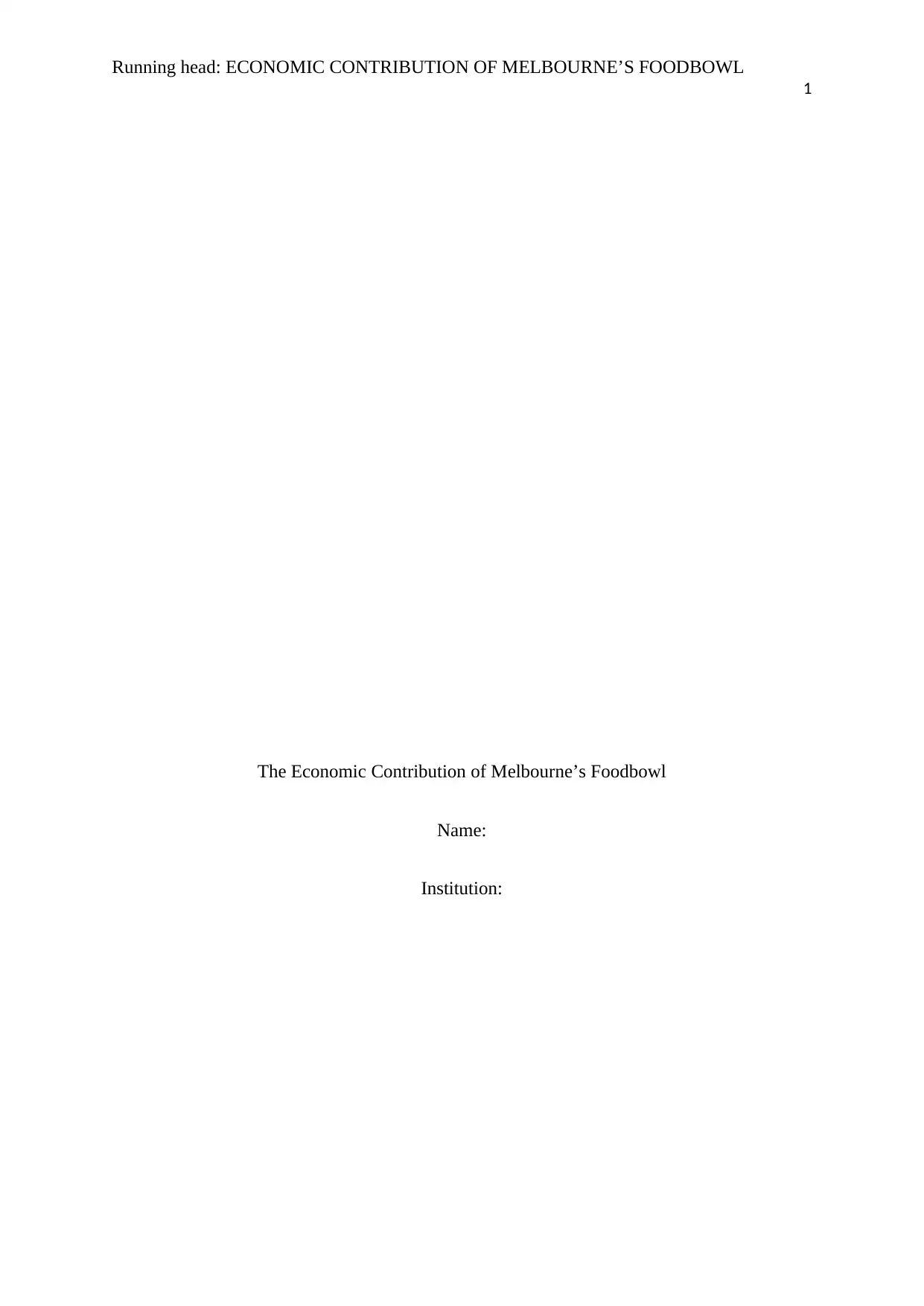
Running head: ECONOMIC CONTRIBUTION OF MELBOURNE’S FOODBOWL
1
The Economic Contribution of Melbourne’s Foodbowl
Name:
Institution:
1
The Economic Contribution of Melbourne’s Foodbowl
Name:
Institution:
Paraphrase This Document
Need a fresh take? Get an instant paraphrase of this document with our AI Paraphraser
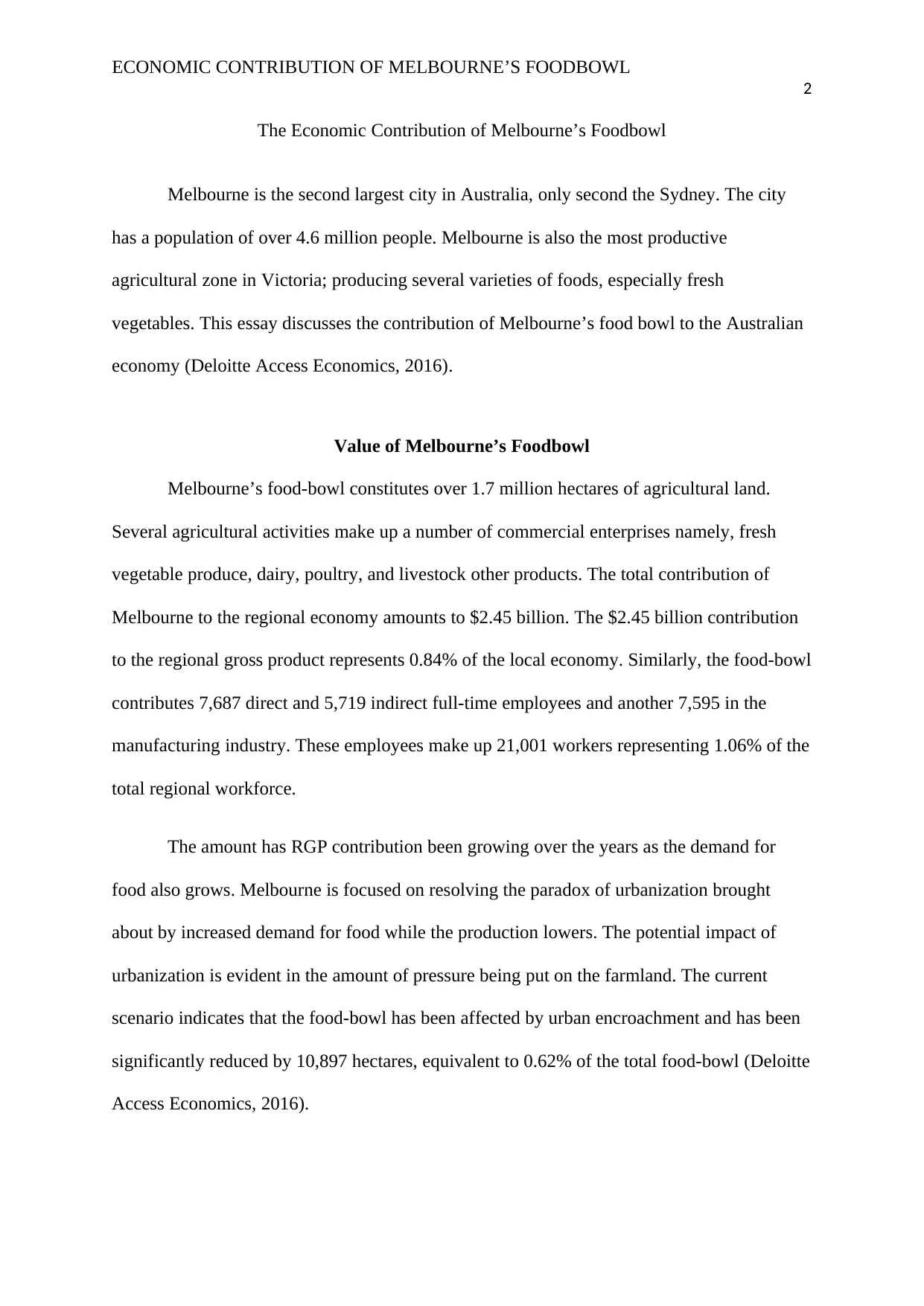
ECONOMIC CONTRIBUTION OF MELBOURNE’S FOODBOWL
2
The Economic Contribution of Melbourne’s Foodbowl
Melbourne is the second largest city in Australia, only second the Sydney. The city
has a population of over 4.6 million people. Melbourne is also the most productive
agricultural zone in Victoria; producing several varieties of foods, especially fresh
vegetables. This essay discusses the contribution of Melbourne’s food bowl to the Australian
economy (Deloitte Access Economics, 2016).
Value of Melbourne’s Foodbowl
Melbourne’s food-bowl constitutes over 1.7 million hectares of agricultural land.
Several agricultural activities make up a number of commercial enterprises namely, fresh
vegetable produce, dairy, poultry, and livestock other products. The total contribution of
Melbourne to the regional economy amounts to $2.45 billion. The $2.45 billion contribution
to the regional gross product represents 0.84% of the local economy. Similarly, the food-bowl
contributes 7,687 direct and 5,719 indirect full-time employees and another 7,595 in the
manufacturing industry. These employees make up 21,001 workers representing 1.06% of the
total regional workforce.
The amount has RGP contribution been growing over the years as the demand for
food also grows. Melbourne is focused on resolving the paradox of urbanization brought
about by increased demand for food while the production lowers. The potential impact of
urbanization is evident in the amount of pressure being put on the farmland. The current
scenario indicates that the food-bowl has been affected by urban encroachment and has been
significantly reduced by 10,897 hectares, equivalent to 0.62% of the total food-bowl (Deloitte
Access Economics, 2016).
2
The Economic Contribution of Melbourne’s Foodbowl
Melbourne is the second largest city in Australia, only second the Sydney. The city
has a population of over 4.6 million people. Melbourne is also the most productive
agricultural zone in Victoria; producing several varieties of foods, especially fresh
vegetables. This essay discusses the contribution of Melbourne’s food bowl to the Australian
economy (Deloitte Access Economics, 2016).
Value of Melbourne’s Foodbowl
Melbourne’s food-bowl constitutes over 1.7 million hectares of agricultural land.
Several agricultural activities make up a number of commercial enterprises namely, fresh
vegetable produce, dairy, poultry, and livestock other products. The total contribution of
Melbourne to the regional economy amounts to $2.45 billion. The $2.45 billion contribution
to the regional gross product represents 0.84% of the local economy. Similarly, the food-bowl
contributes 7,687 direct and 5,719 indirect full-time employees and another 7,595 in the
manufacturing industry. These employees make up 21,001 workers representing 1.06% of the
total regional workforce.
The amount has RGP contribution been growing over the years as the demand for
food also grows. Melbourne is focused on resolving the paradox of urbanization brought
about by increased demand for food while the production lowers. The potential impact of
urbanization is evident in the amount of pressure being put on the farmland. The current
scenario indicates that the food-bowl has been affected by urban encroachment and has been
significantly reduced by 10,897 hectares, equivalent to 0.62% of the total food-bowl (Deloitte
Access Economics, 2016).
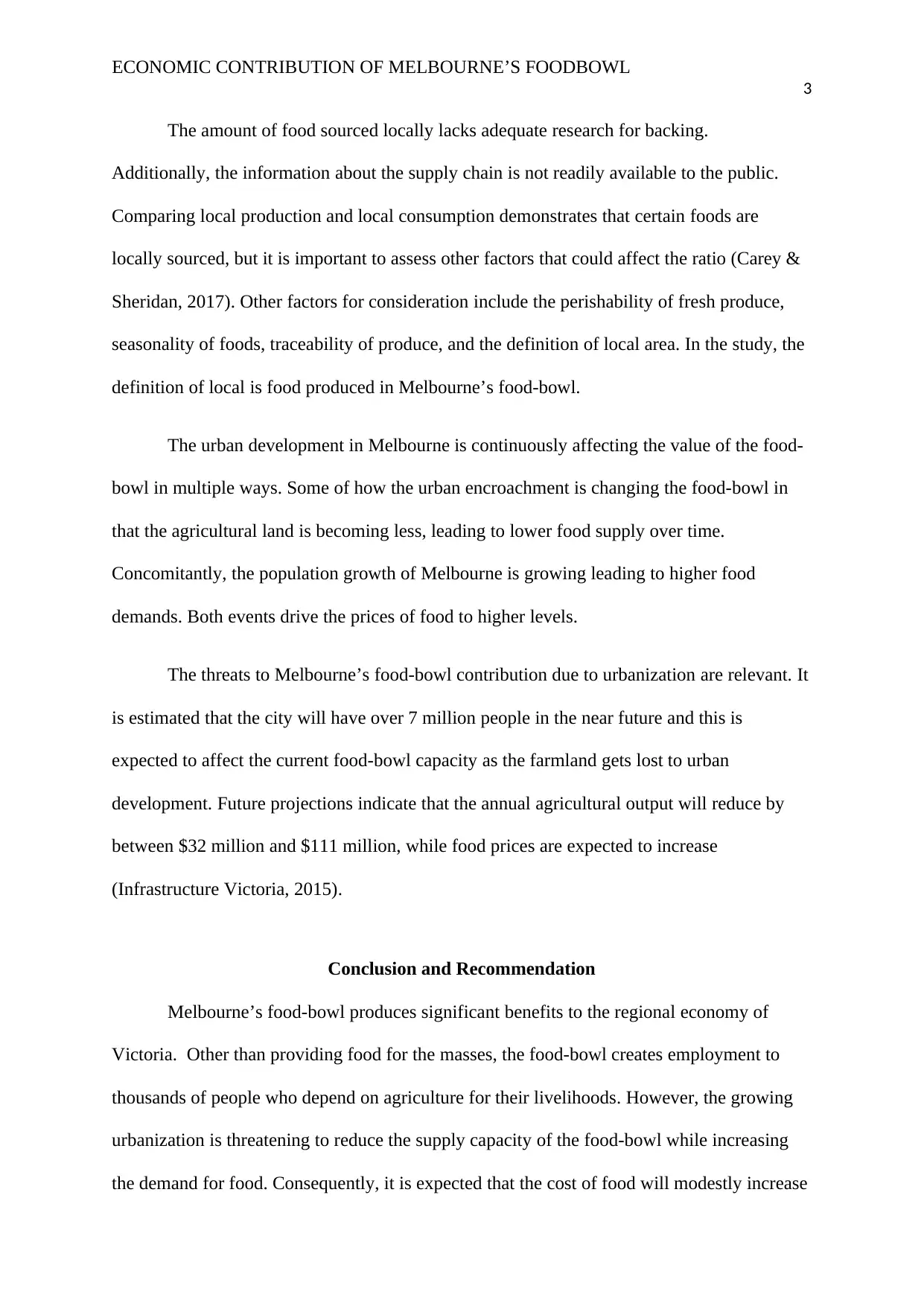
ECONOMIC CONTRIBUTION OF MELBOURNE’S FOODBOWL
3
The amount of food sourced locally lacks adequate research for backing.
Additionally, the information about the supply chain is not readily available to the public.
Comparing local production and local consumption demonstrates that certain foods are
locally sourced, but it is important to assess other factors that could affect the ratio (Carey &
Sheridan, 2017). Other factors for consideration include the perishability of fresh produce,
seasonality of foods, traceability of produce, and the definition of local area. In the study, the
definition of local is food produced in Melbourne’s food-bowl.
The urban development in Melbourne is continuously affecting the value of the food-
bowl in multiple ways. Some of how the urban encroachment is changing the food-bowl in
that the agricultural land is becoming less, leading to lower food supply over time.
Concomitantly, the population growth of Melbourne is growing leading to higher food
demands. Both events drive the prices of food to higher levels.
The threats to Melbourne’s food-bowl contribution due to urbanization are relevant. It
is estimated that the city will have over 7 million people in the near future and this is
expected to affect the current food-bowl capacity as the farmland gets lost to urban
development. Future projections indicate that the annual agricultural output will reduce by
between $32 million and $111 million, while food prices are expected to increase
(Infrastructure Victoria, 2015).
Conclusion and Recommendation
Melbourne’s food-bowl produces significant benefits to the regional economy of
Victoria. Other than providing food for the masses, the food-bowl creates employment to
thousands of people who depend on agriculture for their livelihoods. However, the growing
urbanization is threatening to reduce the supply capacity of the food-bowl while increasing
the demand for food. Consequently, it is expected that the cost of food will modestly increase
3
The amount of food sourced locally lacks adequate research for backing.
Additionally, the information about the supply chain is not readily available to the public.
Comparing local production and local consumption demonstrates that certain foods are
locally sourced, but it is important to assess other factors that could affect the ratio (Carey &
Sheridan, 2017). Other factors for consideration include the perishability of fresh produce,
seasonality of foods, traceability of produce, and the definition of local area. In the study, the
definition of local is food produced in Melbourne’s food-bowl.
The urban development in Melbourne is continuously affecting the value of the food-
bowl in multiple ways. Some of how the urban encroachment is changing the food-bowl in
that the agricultural land is becoming less, leading to lower food supply over time.
Concomitantly, the population growth of Melbourne is growing leading to higher food
demands. Both events drive the prices of food to higher levels.
The threats to Melbourne’s food-bowl contribution due to urbanization are relevant. It
is estimated that the city will have over 7 million people in the near future and this is
expected to affect the current food-bowl capacity as the farmland gets lost to urban
development. Future projections indicate that the annual agricultural output will reduce by
between $32 million and $111 million, while food prices are expected to increase
(Infrastructure Victoria, 2015).
Conclusion and Recommendation
Melbourne’s food-bowl produces significant benefits to the regional economy of
Victoria. Other than providing food for the masses, the food-bowl creates employment to
thousands of people who depend on agriculture for their livelihoods. However, the growing
urbanization is threatening to reduce the supply capacity of the food-bowl while increasing
the demand for food. Consequently, it is expected that the cost of food will modestly increase
⊘ This is a preview!⊘
Do you want full access?
Subscribe today to unlock all pages.

Trusted by 1+ million students worldwide
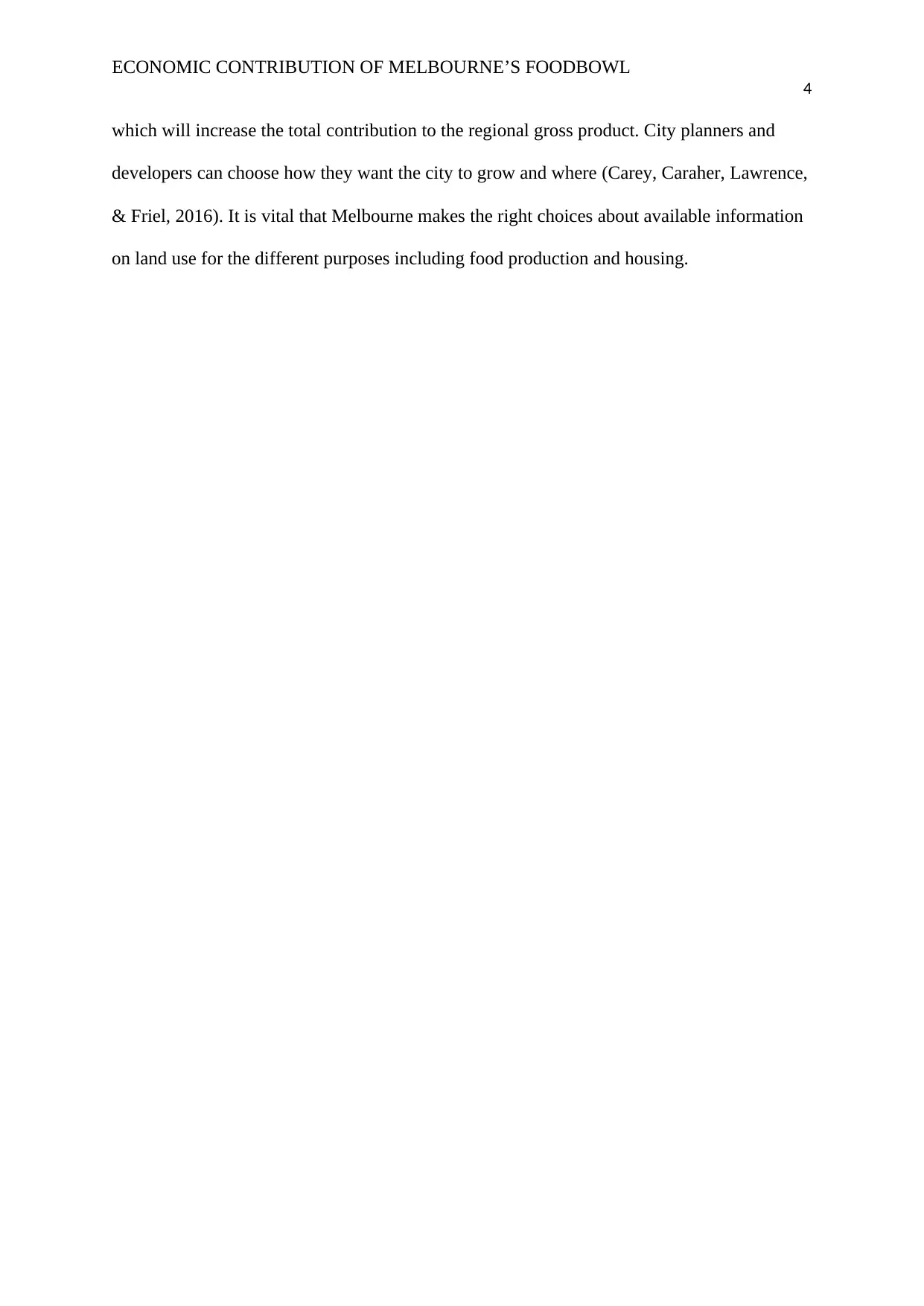
ECONOMIC CONTRIBUTION OF MELBOURNE’S FOODBOWL
4
which will increase the total contribution to the regional gross product. City planners and
developers can choose how they want the city to grow and where (Carey, Caraher, Lawrence,
& Friel, 2016). It is vital that Melbourne makes the right choices about available information
on land use for the different purposes including food production and housing.
4
which will increase the total contribution to the regional gross product. City planners and
developers can choose how they want the city to grow and where (Carey, Caraher, Lawrence,
& Friel, 2016). It is vital that Melbourne makes the right choices about available information
on land use for the different purposes including food production and housing.
Paraphrase This Document
Need a fresh take? Get an instant paraphrase of this document with our AI Paraphraser
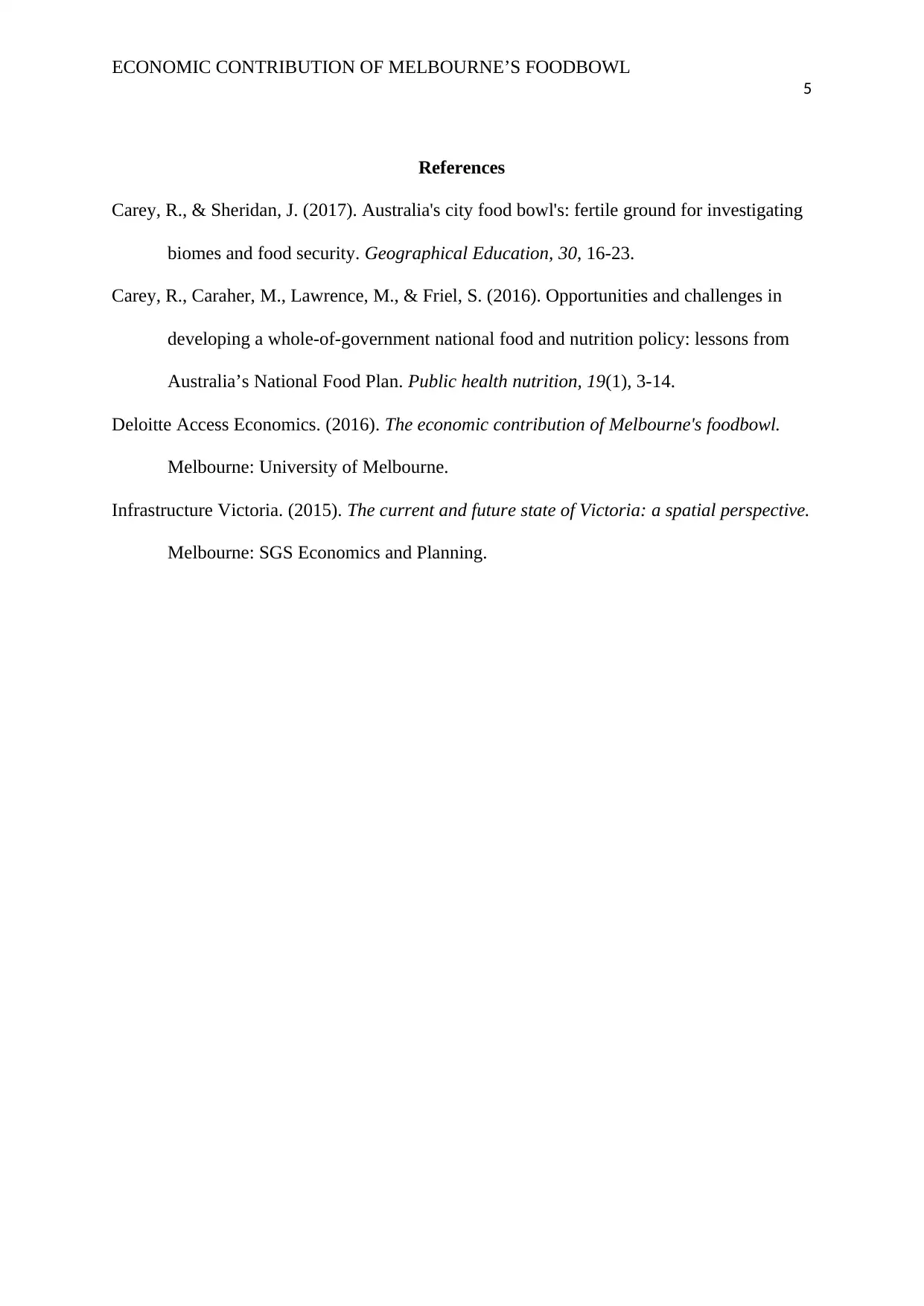
ECONOMIC CONTRIBUTION OF MELBOURNE’S FOODBOWL
5
References
Carey, R., & Sheridan, J. (2017). Australia's city food bowl's: fertile ground for investigating
biomes and food security. Geographical Education, 30, 16-23.
Carey, R., Caraher, M., Lawrence, M., & Friel, S. (2016). Opportunities and challenges in
developing a whole-of-government national food and nutrition policy: lessons from
Australia’s National Food Plan. Public health nutrition, 19(1), 3-14.
Deloitte Access Economics. (2016). The economic contribution of Melbourne's foodbowl.
Melbourne: University of Melbourne.
Infrastructure Victoria. (2015). The current and future state of Victoria: a spatial perspective.
Melbourne: SGS Economics and Planning.
5
References
Carey, R., & Sheridan, J. (2017). Australia's city food bowl's: fertile ground for investigating
biomes and food security. Geographical Education, 30, 16-23.
Carey, R., Caraher, M., Lawrence, M., & Friel, S. (2016). Opportunities and challenges in
developing a whole-of-government national food and nutrition policy: lessons from
Australia’s National Food Plan. Public health nutrition, 19(1), 3-14.
Deloitte Access Economics. (2016). The economic contribution of Melbourne's foodbowl.
Melbourne: University of Melbourne.
Infrastructure Victoria. (2015). The current and future state of Victoria: a spatial perspective.
Melbourne: SGS Economics and Planning.
1 out of 5
Related Documents
Your All-in-One AI-Powered Toolkit for Academic Success.
+13062052269
info@desklib.com
Available 24*7 on WhatsApp / Email
![[object Object]](/_next/static/media/star-bottom.7253800d.svg)
Unlock your academic potential
Copyright © 2020–2025 A2Z Services. All Rights Reserved. Developed and managed by ZUCOL.





